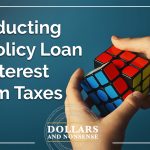In this episode, we discuss one of the most common questions that comes up as you plan for retirement, “How much money can I safely withdraw from my accounts without running out of money?”
Ensuring you have enough money to last you is probably one of the most critical questions to answer for people planning for retirement, especially if they’ve built up their assets in a more conventional way. In retirement, the greatest fear is that you will outlive your money and then be forced to live on the charity of family members or the government. We break down the options and answers today.
Topics Discussed:
- How economic fluctuations and inflation can rob you of your future
- Why the way traditional structured assets are not doing the best job for most people
- Simplifying the math to see what the future really holds for your money
- Understanding the doubling effect that takes hold and reduces your wealth when you move to a distribution phase
- The risk of using volatile assets to fund your future
- Why and how whole life policies are a non-volatile asset that only goes up with the right structure
Episode Resources:
- Gain access to our Secret Banking Masterclass now FREE to listeners of the podcast here now
- What is Infinite Banking
- Who was Nelson Nash?
- CREDIT: Episode art background photo by photo by James Hose Jr
Episode 139 Transcript: How to ensure your retirement money doesn’t run out
Nate: In this episode, we discuss one of the most common questions that comes up as you plan for retirement. How much money can I safely withdraw from my accounts without running out of money before I die? She’s Holly, and she helps people find financial freedom.
Holly: He’s Nate, he makes sense out of money. This is Dollars and Nonsense. If you follow the herd, you will be slaughtered.
Nate: All right. Well, we’re diving into a fun one today, a lot to talk about, a lot of ground to cover. This is probably one of the most important questions that can be answered for people planning for retirement, especially if they’ve built up their assets in a more conventional way. This is a very common question that we get and probably the most important question. How much can I safely pull without running out of money? Because in retirement, the greatest fear is that you will outlive your money and then, I don’t know, have to live on the charity of family members or the United States government or something of that nature, which is everyone’s biggest fear. So there’s a lot of planning that needs to take place to ensure that you do not run out of money.
Holly: I think too, Nate, the fear of, “I’m going to have to go live with my children, or I’m going to be a burden to them, or am I going to have money to pay for just normal stuff?” I mean, you see it across the US, across the world, where individuals actually planned accordingly to what they thought was enough money that they saved. And actually they end up, and it’s sad, but they’re buying dog food and cat food and eating that because they can afford to buy that versus actual real meat or real food for themselves. Because they don’t want to be a burden to somebody else, or they don’t have the money to literally buy real food.
Nate: So this is a big concept. It’s a big thing. I don’t know if we can really just do this in one episode, but we’re going to put forth some thoughts on how to do it. I think one of the first things to note just in general, Holly, this is one of the reasons why you and I are not huge fans of the concept of retirement anyway, by the way. I would prefer to use financial freedom, financial independence, as opposed to the normal idea of retirement. The normal idea of retirement is build up a big pile of money and then liquidate that account and hope that the account doesn’t hit zero while you’re still alive. The problem is you find individuals work their whole lives with this goal of tiring. So they never really enjoy their job, they’re never really dedicated to it. So a lot of times they won’t switch careers or do things they would actually enjoy because the pay’s good and they’re hoping to just get out of the workforce and retire.
Honestly, it ruins your working life. And then whenever you get to retirement, maybe the whole time you were working, by the way, you maybe were afraid you wouldn’t accumulate enough and that fear does not go away when you retire.
Now you’re afraid that all these bad things could happen. Economic collapses, inflation, all sorts of things, and that you won’t have enough to make it. So all that being said, Holly, we’re not huge fans of it to begin with because it makes people afraid, makes people upset. It is not a happy thing for, I would say 90% of people. However, the financial independence model of purchasing assets, investing money and doing things that produce passive income that you can’t ever stop receiving, that’s a much safer area to be in. And we think that everyone should be financially independent.
Maybe change your idea of retirement. I thought I’d throw that caveat out there.
Holly: I want to say, Nate, too that when you think of financial independence, you’re making decisions not out of fear and not out of reaction. You’re making decisions based on a freedom and a peace that you can guarantee or you know where the money is, and you’re not basing it on what if there is an economic collapse? What if this happens? You literally have that freedom. And I think with retirement, and when we think of that and not having income or passive income, we think of something we have no control over. We really have no idea how much money we need if we do it in the traditional sense. And we really don’t know what that looks like because we’re listening to everybody else telling us what to do with our money. So we’re making those decisions out of that fear, literal fear of I don’t ever want to run out of money. And what if it’s not enough?
Nate: So one of the reasons why this is such a dangerous topic is really because the assets that are commonly associated with retirement, which would be the stock market, mutual funds, bonds, all housed inside retirement programs, these are the most common assets in America to build up for retirement. The problem is those assets are not doing a very good job at producing income. This is the problem. So people are very surprised whenever you meet with a financial planner, a retirement advisor, and you come in with a million dollars and you think that sounds like a nice big round dollar amount, and you’re happy with it, and you come to him and you’re trying to make some plans for transitioning to retirement.
And he says to you, “Holly, you can have about 30 to 35 grand a year from your million dollars.” And you’re like, “What?
That does not sound like very much money. I built a million bucks, shouldn’t I be able to pull more out?” Once again, we’re going to dive into some of the reasons why that’s the case, Holly, here really quick. But essentially, the problem is that the assets that most of us have been taught to build up, while they may be good at appreciating and value over time, it actually works differently when it’s time to have these assets produce income. And some such assets produce income much easier than others. We’ll dive into why the number is so small.
Holly: Really what we’re looking at here is what they call a sequence of returns. What we’re really going to look at is you put in all this money over a 25 year period, and you end up with that same amount of money. But what happens with the volatility of the market and stuff over a period of time, even if you only pulled out, Nate, like that $30,000 a year or
$35,000 a year on a million? You could run the risk of running out of money because it is different when it’s capitalized over time versus pulling money out to distribute to yourself and live on. That’s a very big difference because you don’t have the time typically to recuperate that money.
It really is a matter of having an asset that actually creates passive income that’s not so volatile over life. That for us, I mean, we’re very big into the Infinite Banking Concept and purchasing dividend, paying whole life insurance because of what it produces and there’s not that volatility, which we’ll speak to a little bit later on. But really the reality is, can you live on whatever you put in only taking out 3% of that over the time you’re going to retire?
Nate: Yeah. So let’s dive in into the why the recommendation is so low, by the way. So you’re going with the retirement advisor, you’ve got your million dollars and they say you can typically take out three to maybe up to 4% if you are a little aggressive from that account each year, and you’ll have a very low risk of running out of money. And you’re sitting here thinking to yourself, why is the number so low? Why can I only pull out three to 4% of my big pile of money each year? In other words, I got a million dollars, why can it only create income of 3% for me? You’ll say to yourself, the stock market has done way better than that forever over a period of time. The average return over every 30 year timeframe is higher than that. So why is he saying I have this tiny little measly number to pull out?
That’s what Holly brought up, that the rules change whenever you start taking income from your pool. In other words, the accumulation period of time while you’re building wealth, there’s actually different rules essentially apply to that timeframe than they do to the distribution timeframe, like the retirement income timeframe. There’s different rules that apply and there’s reason for that, which, Holly, you brought up, which is called the sequence of return risk. It’s getting more and more popular, this concept. Retirement advisors have always known about it, but now people are just talking about it more often, is this idea of the sequence of return risks. In other words, whenever you are building up money, it doesn’t really matter what the sequence of returns is. So what that means is, as we all know, the market goes up and down over time, but it does tend to gradually go up as time goes on.
At least that’s what we’ve experienced for the last 100 and some years. So while you may have bad years, good years, bad years, good years, over a long period of time, yeah, most people do okay in the market. Let’s just say, you average, you build wealth for 30 years inside of this account and it’s gotten up and down, up and down. But you maybe have put in 500,000 over that time, you’ve got a million dollars now. So you’ve made some money, things are going well. The reason that it changes, the reason why the average doesn’t matter anymore when you decide to retire is because you now no longer have time on your side. The moment that you to retire and start pulling money out of the account, it really doesn’t matter.
I could give you a crystal ball and I could tell you, Holly, like I could say, “Hey, this is the average rate of return. I’m from the future, by the way, I’m from the future. I come from 30 years down the road. You’re 65 now, I come from 30 years down the road. And over these last 30 years, the market has averaged 8%.” This is what I would tell you. “The market has averaged 8%. So if you have a million dollars, 8% of a million is 80,000.” So you think to yourself, okay, well, if the market average is 8% over 30 years and I’ve got a million dollars now, and I have a crystal ball that I know for a fact, the average rate of return is going to be 8% over that timeframe. Then you think to yourself, I could probably pull out 80 grand a year and die and leave my million dollars still. I just take the growth out of it. 8% of a million is 80,000. I pull out 80,000, I leave a million to my family. We’re all good to go.
In this scenario, I’m even giving you the benefit of the doubt that you have the crystal ball. Then you actually decide to retire, and you find that your money has run out in about 15 to 20 years. And you’re like, “Well, that guy from the future guaranteed. He said that I averaged 8%. Well, how did I run out of money?” The reason is because whenever you are distributing money, the rules change. And what we mean by that is when you move to a distribution phase, every time there’s a down year, you get double affected. So what we mean by that is, I got a million dollars and let’s say the very first year we have a COVID crisis or something, or who knows what happens. And suddenly the market loses 40% like we saw in the dot-com bubble and the housing bubble recently and so forth.
So your million dollars is now 600,000, but you also have to start withdrawing money to survive. Because this is the pool of money you’re taking income from. So your million dollars is now 600,000. And you think to yourself, because you’ve got the crystal ball of, if it’s going to average 8%, the market’s going to turn back around. So you go pull out 8% of your million that you had, so you take out income of 80,000. Now your account balance is 520,000 after the end of the first year. Now, the market is going to go back up, but the question is, does it have enough steam? Does it have enough power now to continue giving you this higher income amount over the period of time for the next 25 years of retirement? And what they found is, no, it does not. It does not.
You are going to stifle the growth by withdrawing money from it to produce income. You’re going to stifle the growth, so it’s never going to be able to get back up to a sustainable level.
So you will slowly deplete the balance down to zero over your retirement time. This is why retirement advisors say the safe withdrawal rate is this tiny little 3%, three and a half. And if you want to be a little risky, you shoot for 4%. Which doesn’t sound like very much in the market, but this is what they’re trying to tell people. The rules have changed.
The average return of the market goes out the window. If we have a few bad years early on in your retirement, your entire balance could go down so dramatically then it will not be able to support decent withdrawal rates.
So to play it safe, plan for about 30 to 40 grand a year per million dollars, which for a lot of people is like a slap in the face. This is what’s called sequence of return risk, that while the market will average a positive, solid return over your retirement, it actually can become a huge issue if some bad years occur early on, kill off all your workers, which are your dollars. So you got less workers working for you and you have to kill some off just to survive anyway, by taking out distributions. It will never gain steam again and be able to replenish what ran out.
Announcer: Are you still stuck in insecurity and uncertainty? Do you want to feel like a financial genius and confident about your future? Holly and Nate have prepared something exclusively for Dollars and Nonsense listeners. It’s called the Secret Banking masterclass. You can gain free access to this course by visiting livingwealth.com/secretbanking. That’s secretbanking, all one word. The course will share with you how the conventional system stacks the deck against you, and exactly how to break free from their system.
We believe in challenging the status quo. We believe in defined conventional well tools while maintaining traditional values. After all, most of those conventional tools only ever seem to make someone else on the inner circle rich. Visit livingwealth.com/secretbanking. That’s secretbanking, all one word. Ease your worry, and start your journey towards security today. Visit livingwealth.com/secretbanking. Now, back to the great episode with Nate and Holly.
Holly: And even though you had the crystal ball in this scenario, you knew it was going to make 8%. You don’t know whether it’s going to be in the early years that it’s volatile, in the middle years or in the end. Two people with the exact same million dollars and retiring at two different times can both average 8%. One can be ahead with money and one can run out of money because of that volatility and not knowing when it’s go going to hit. That is why we live in this fear of maybe that 3% is okay. There’s people that will only pull out the 3%, Nate, though, and still run out of money.
Nate: Isn’t that crazy? That’s not a risk free amount. If I pull 30 grand out a year in my retirement, I actually might run out of money still.
Holly: Yeah.
Nate: It’s crazy when it’s in these types of normal assets.
Holly: If you pull it out, and most of us, when we retire, if we’re around that 65 year age or 70, people are living longer lives, so you need more money to live on because you’re going to live longer. So even that 3% becomes dramatically affected because you could run out of money before you even hit 20 years down the road at age 85. Or you could have more money, but you don’t know. And that’s that fear and that volatility of which you guys have to start thinking about, I want to put my money in something that creates passive income, that doesn’t have these volatility swings, that I can withdraw the X amount of dollars at this age without risking what the market’s doing to affect the money.
Nate: Yeah. Essentially, volatile assets are just… It’s okay to build wealth, you can get away with building wealth and volatile assets because you’re not having to take any money out, you’re not having to kill off the workers per se, and you have time to let the market rebound. In distribution phase, the rules change. The time in the market doesn’t matter anymore. The fact that you may run out of money quickly due to a couple bad years of markets, performance, needs to be taken into account. That’s why the recommended withdrawal amounts are so low by most financial advisors, because the assets, we do not know what they’re going to do. Holly and I were sent this document that describes this happening in real time.
You have same two individuals, they each have $700,000 and they’re going to take out 35 grand a year over a 25 year retirement. And during that 25 year retirement, guys are going to average 8% rate of return in those assets. Of course, some years are going to go up and some years are going to go down. If you have pretty solid rates of return in the early years, then you’re pretty much guaranteed to make it out a lot. In fact, the guy who had the same average rate of return, actually the same rate of return, they just flip it by the way. In other words, one guy gets 2% the first year and negative 38% the last year. Whereas the other guy gets negative 38% the first year and 2% the last year. And all the returns are just flip flopped. It’s even the same interest numbers, they’ve just changed, they’ve just flip flopped when they were going to occur. An interesting idea, but nonetheless, it’s the same interest rates, the same average rate of return.
One guy dies having taken out 35 grand a year, every year in his retirement, and he still leaves about 2.8 million. The other guy had the same numbers projected for his 30 years. They just changed the order, the sequence of returns, and he runs out of money in 19 years and his broke and he’s still got five, six years left of life. So essentially what we’re saying is, it can be risky to use volatile assets to produce income.
It’s less risky to build wealth with them per se, because you got time to rebound and things like that. But once it’s time to distribute the money, that risk is magnified to why there’s so much fear around this. If we want to transition, essentially how to know how much you can save from withdrawal? It’s really nice to have of assets that don’t ever go down.
That’s number one. So that way we know how much we can withdraw safely without risk. The policies that we encourage people to use to practice into the banking are great tools for this because we know exactly what to expect in retirement. When we’re taking out income, we can plan well. So at least we can reduce dramatically, the fear of running out of money. We probably can’t take it away because you never know how long you will live. But nonetheless, we can reduce that fear dramatically.
Other things as well, like rental properties and things that produce passive income themselves are always great assets to help whenever you’re wanting to transition from active work to more of a passive work environment, which would I encourage people to call their retirement time, passive work, continue to produce value. The assets that are being built up by you, that you’re choosing to place money in, you have to understand, are they both good at accumulating money, but are they also good at distributing and creating income from it? If that is one of your goals.
Holly: And that’s a key. If you guys haven’t been listening right now, Nate just gave you some great one, two, three steps.
Nate: Absolutely. I hope I’m creating some value for somebody.
Holly: With those steps, you have to ask yourself if it’s great producing money for you or building up wealth over time, is the same true when you start distributing the money? You don’t want to kill the workers. You need a passive stream of income as well. And you need to know something that isn’t going to lose money over time. Nate, I’m just going to throw it out there. One of the only and safest ways in my viewpoint, it is, is through a life insurance policy that’s paying you dividends because it’s growing over time, but you can take distributions out as well and not lose that, you don’t have that volatility.
Nate: Yeah, exactly right. The best way to plan for retirement, to answer the question, how much income can I safely withdraw without running out of money before I pass away?
The answer to that question is to build up assets that produce income by themselves. There is no guarantees in life, but if you were to build assets that produce passive income, suddenly you can be fairly sure what that income’s going to be like. Whereas if you build up assets that are not actually focused on producing income, but are more focused on appreciation, market valuations, that would be hence the stock market, things of that nature. You can sell those off to produce income. That’s what it takes by the way. And when you have mutual funds and stocks and bonds and different things, you’re selling assets at whatever the market value is at the time in order to produce your income.
That strategy, due to the volatility involved in market valuations, adds another risk level that essentially means that these assets are not that good at producing consistent safe income. They’re just not very good at it. So doing things like policies… I’ve even had a success with some people with annuities. I don’t normally suggest annuities mainly because I also don’t like the idea of retirement, but nonetheless, they will spit out guaranteed income every single year. Some people actually enjoy that because they handle the idea of running out of money before they die.
There’s some assets that are great at producing income and there’s other assets that are better at accumulating value. But actually when you look under the hood, they’re pretty bad sending out income. So how much money can you safely withdraw from your accounts? A pretty low amount when they’re in a volatile asset, typically higher amounts whenever they are safer. And there really is no safer asset out there right now that can compete with what we get inside of a dividend paying whole life policy built for banking. And then especially when you add the ability to leverage the policy to go purchase other assets, preferably ones that produce passive income themselves, suddenly you’ve got a pretty good system that should help you both build wealth while also being able to distribute it very easily.
Holly: That was well said, Nate.
Nate: Well, that’s good. That’s good. Anything else? We could talk about a lot of other areas, but I don’t want to belabor the point.
Holly: I think it was a great question that you pose, and I think you as listeners need to ask yourself that, is it generating that wealth over time? It’s building wealth over time, but does it do the same thing when you want to distribute that wealth? When you want to take that income, is it going to perform the same way and do you have that same amount of time and you really don’t with something that’s volatile, but it’s a simple question to ask yourself when you’re considering, where do I want to put this money and is this creating passive income? And how does this build wealth for me in the future? Not just now, but in the future.
I think, you guys, we have to think about life as we all are going to graduate from this earth at some point in time, but it takes time to build wealth, to accumulate wealth. And in the same way, how do you want your life to be once that wealth is accumulated. Nate and I, neither one of us really believe in retirement, but you got to have something passive or still be contributing or having something come in once you decide this is the career I’m done with or I’m over, I’m going to do something else with my life.
Nate: Yeah. The greatest way to not ever be afraid about if you outlive your assets is to work for as long as you’re possible producing active income and then have a much shorter retirement period. That’s the way you guarantee it. If you find work that you actually enjoy doing, or you transition out of a job into another actual paying career, but maybe at a lower amount, but continue to produce value, this is the greatest retirement plan you can have doing something you enjoy and make money while doing it. That is the guaranteed way to retire well, “retire.” Maybe transitioning into maybe less time at the office or a different career altogether.
Nonetheless, that’s my recommendation. That’s what I plan on doing. Or at least if you want to leave the workforce completely, then focus, not on a big nest to egg inside of retirement programs, focus on buying assets that produce passive income themselves like policies or rental properties or things of that nature that you can count on, that are consistent, that you can make a real plan with a lot of certainty as opposed to the uncertain world of market volatility. With that being said, I guess we should wrap up, Holly.
Holly: Yeah, we should.
Nate: Yeah, this has been Dollars and Nonsense. If you follow the herd, you will get slaughtered.
Holly: For free transcripts and resources, please visit livingwealth.com/e139.
Announcer: Dollars and Nonsense podcast listeners, one more thing before you go. Ease your worry and start your journey towards security today. Visit livingwealth.com/secretbanking. You’ll gain instant free access to the special one hour course Holly and Nate made for you. Again, that’s livingwealth.com/secretbanking.













